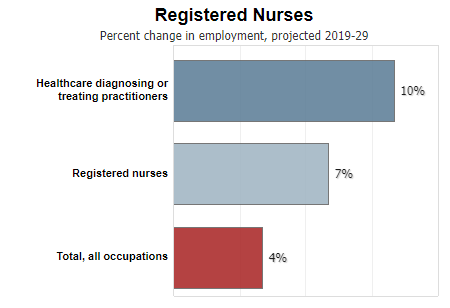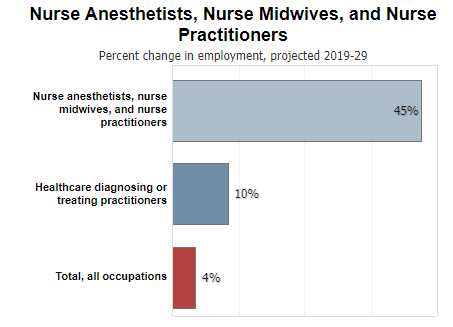Introduction
The author’s current career goal is to become a nurse via the nursing program. From there, they will decide how they want to continue the career, though the current idea is to proceed to obtain a master’s degree in nursing and seek out an advanced practice nursing certification. They chose this major and career because of their personal characteristics, such as being good at caring for people and enjoying doing so. With that said, the author is also aware of the discussion currently going on regarding the impending nurse shortage, which has also motivated them to choose nursing. For the purposes of this assignment, they visited the website of the U.S. Bureau of Labor Statistics and gathered information regarding the career path. The results presented below suggest that it is a highly attractive option that they would also recommend to high schoolers looking for a future choice.
Data Analysis
Overall, the position of registered nurse appears to have performed well throughout the past decade. Per Lockard and Wolf, it was projected to add 711,900 new jobs between 2010 and 2020, going from 2.7 million to 3.4 million, mostly driven by the aging U.S. population and its increased demand for medical services (95). As of 2019, the real figure, as shown by “Registered Nurses,” was at 3.1 million, indicating the figure was not achieved, and the projections were somewhat excessive. The growth rate is substantial, and the BLS projects growth of another 221,900 jobs before 2029, the fifth-largest increase in terms of raw numbers among all occupations listed (“Most New Jobs”). With that said, as Fig. 1 indicates, the rate of growth is lower than that for all healthcare diagnosing or treating practitioners. The reason may be that, in the past, growth for the profession could have been too fast at the expense of the other jobs.

In terms of potential earnings, the position of the registered nurse appears to be attractive. Lockard and Wolf list the median wage for the profession at $64,690 as of 2010, which was near twice the median across all occupations at $33,840 (101). Per “Registered Nurses,” the median wage as of 2019 was $73,300, and the overall indicator was $39,810. These figures represent substantial growth overall, though it should be noted that the 13.3% median wage growth for registered nurses is lower than the 17.6% increase throughout all industries. The competition for jobs mentioned in “Registered Nurses” may be a reason for this difference, as the high number of applicants lets medical facilities set lower wages. However, this is just an assumption not necessarily backed by data, and the other factors influencing this competition will be discussed later on.
Once a person has accumulated some experience, they can proceed to obtain a Master’s degree and then apply for certification as an advanced practice nurse. This position is currently relatively new but seeing rapid adoption across the country as the demand for skilled medical personnel increases and can no longer be met by physicians and similar professions. As a result, “Fastest Growing Occupations” projects a 52% increase in the number of nurse practitioner positions, which are the most common type of advanced practice nurse. As shown in Fig. 2, the growth across all types is 45%, which over ten times higher than that for all occupations. This increase represents 117,700 additional high-skilled jobs, which is appropriate for a position that required both extensive education and experience. As such, the author’s beliefs about the high demand for the profession appear to be supported by the available evidence.

In terms of earnings, the more senior position is correspondingly more attractive, with all types of advanced practice nurses earning six-figure wages. “Nurse Anesthetists, Nurse Midwives, and Nurse Practitioners” claims that the median salaries for nurse anesthetists, midwives, and practitioners are $174,790, $109,820, and $105,030, respectively. These figures are 138%, 50%, and 43% higher than those for registered nurses and 339%, 176%, and 164% above the overall median. It should be noted that the relatively high nurse anesthetist wages are counteracted by the position’s low availability, with 44,900 positions existing currently and 51,000 expected to exist by 2029. As such, while the position is highly desirable, it is also going to be challenging to obtain. The author will also need to determine whether they want to work as an anesthetist and assist in various situations where the patients require anesthesia over other potential nursing occupations.
In the short term, it should be noted that there are multiple ways to become a registered nurse, not all of which lead one to stand in the same position in the field. To become eligible for the license, one can obtain a bachelor’s or associate degree in nursing or complete an approved nursing program. With that said, “Registered Nurses” suggests that those with a bachelor’s degree will have a better position in the workplace, especially if they have knowledge or work experience in a particular field of care. Their competencies are expected to be higher than the others, and it will be easier for them to specialize and advance due to their qualifications and knowledge. It is still possible for others to advance, but positions that do not require a master’s degree or advanced nursing certification may be easier to achieve.
When counseling a high school student looking for a major to choose, the author would explain to them that they chose nursing because they enjoyed caring for people and considered themselves capable in this regard. With that said, they would also warn the person about the potential hazards of nursing, such as the high stress imposed by the work hours and the specifics of the job. If the student were capable of withstanding the pressure, the author would recommend that they strongly consider nursing. The job prospects are excellent, with massive projected demand growth and rapidly increasing availability of high-paying positions for experienced workers.
Conclusion
The author chose nursing both because of their affinity with the profession and because they heard that it had excellent future prospects. This research into the data provided by the BLS confirmed this belief, as nursing appears to overall be among the most promising fields in the United States. The number of registered nurses has been grown steadily at a faster rate than that of the total jobs over the last decade, and this tendency is expected to continue in the future. Meanwhile, the more advanced position of the advanced practice nurse is experiencing rapid growth, mostly driven by the rising demand for nurse practitioners. The author is satisfied with their choice and would recommend it to others, assuming they were able to handle the job.
Works Cited
“Fastest Growing Occupations.” U.S. Bureau of Labor Statistics, 2020, Web.
“Most New Jobs.” U.S. Bureau of Labor Statistics, 2020, Web.
“Nurse Anesthetists, Nurse Midwives, and Nurse Practitioners.” U.S. Bureau of Labor Statistics, 2021, Web.
“Registered Nurses.” U.S. Bureau of Labor Statistics, 2021, Web.
Lockard, C. Brett, and Michael Wolf. “Occupational Employment Projections to 2020.” Monthly Labor Review, 2012, pp. 84-108.